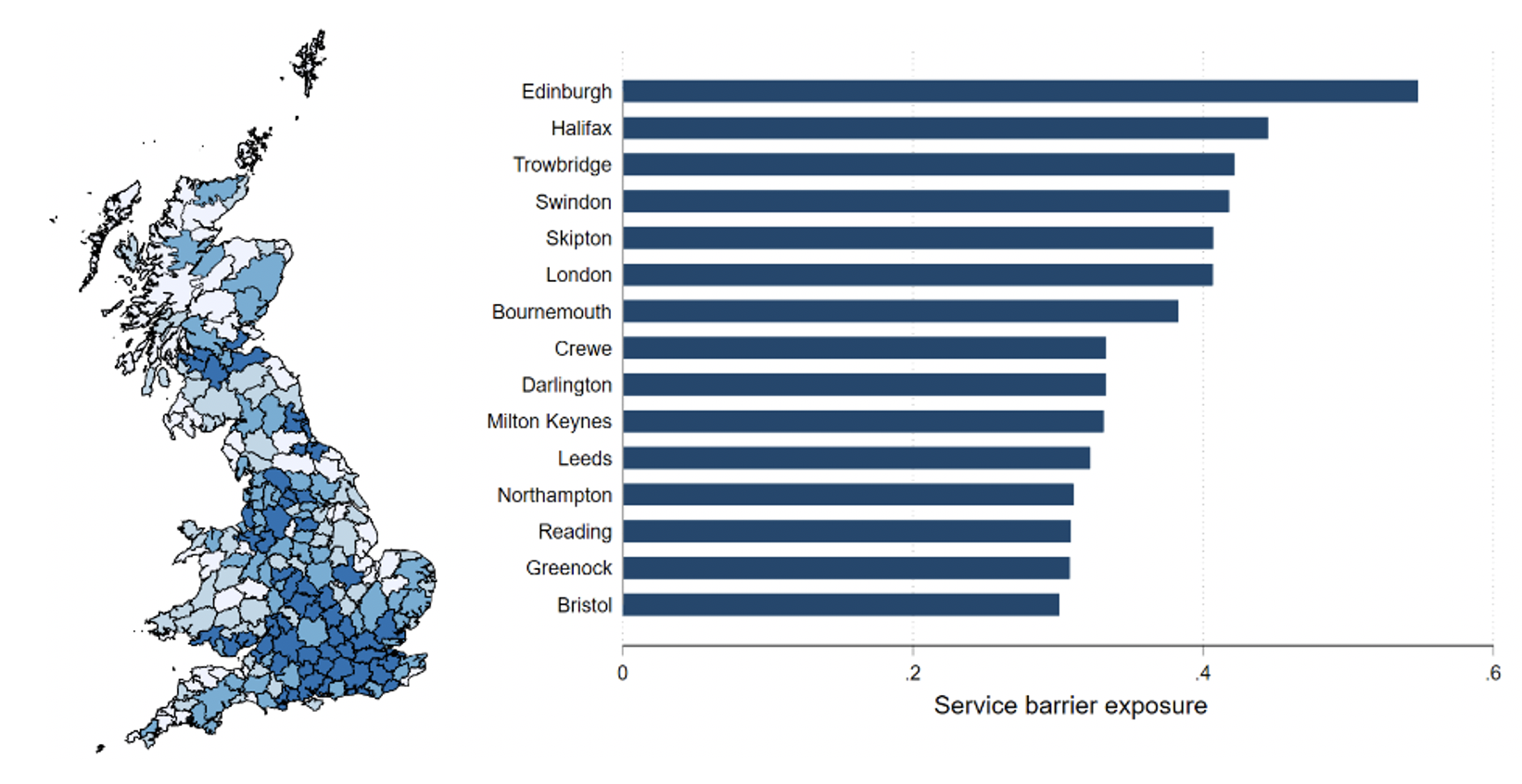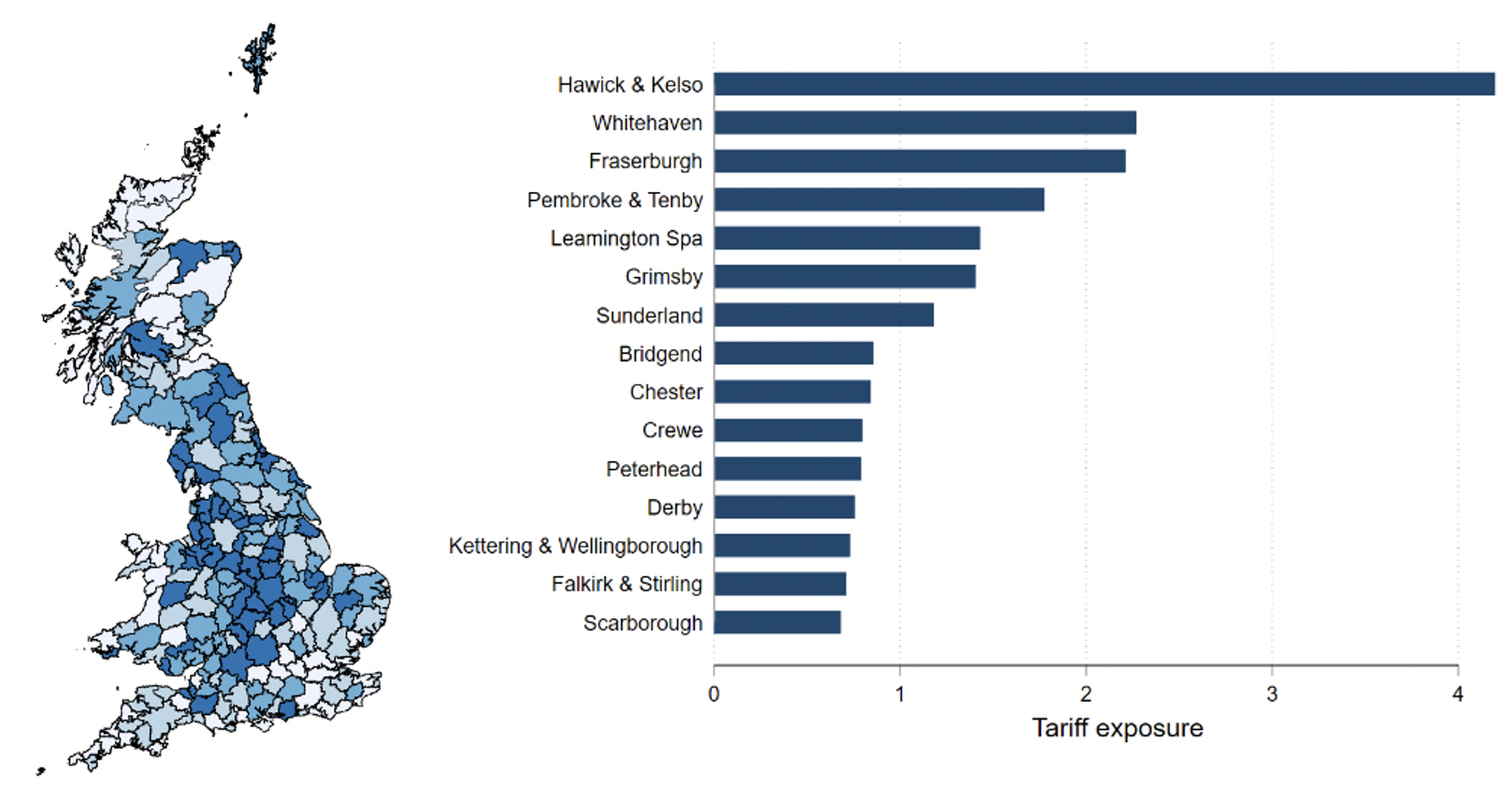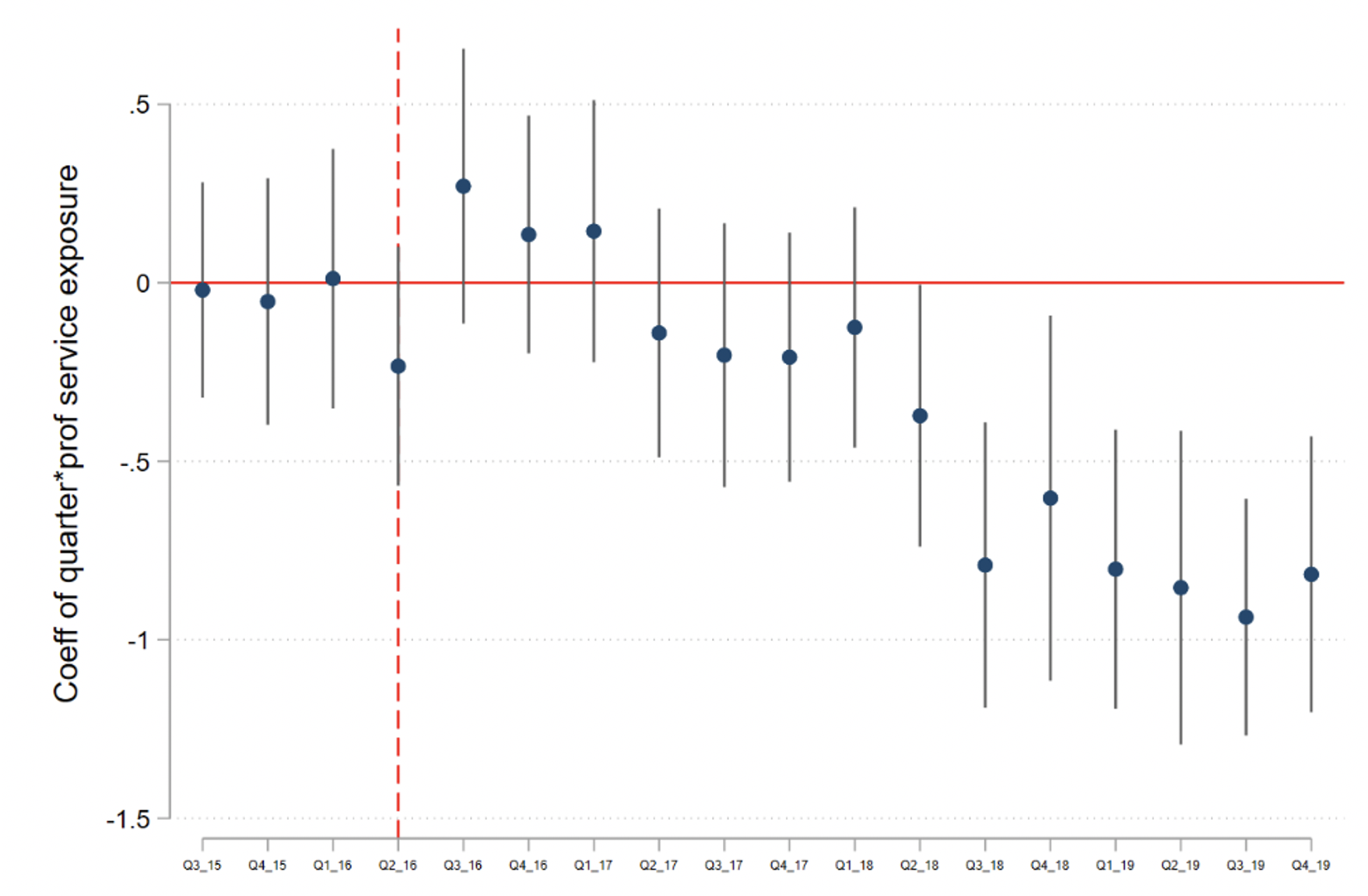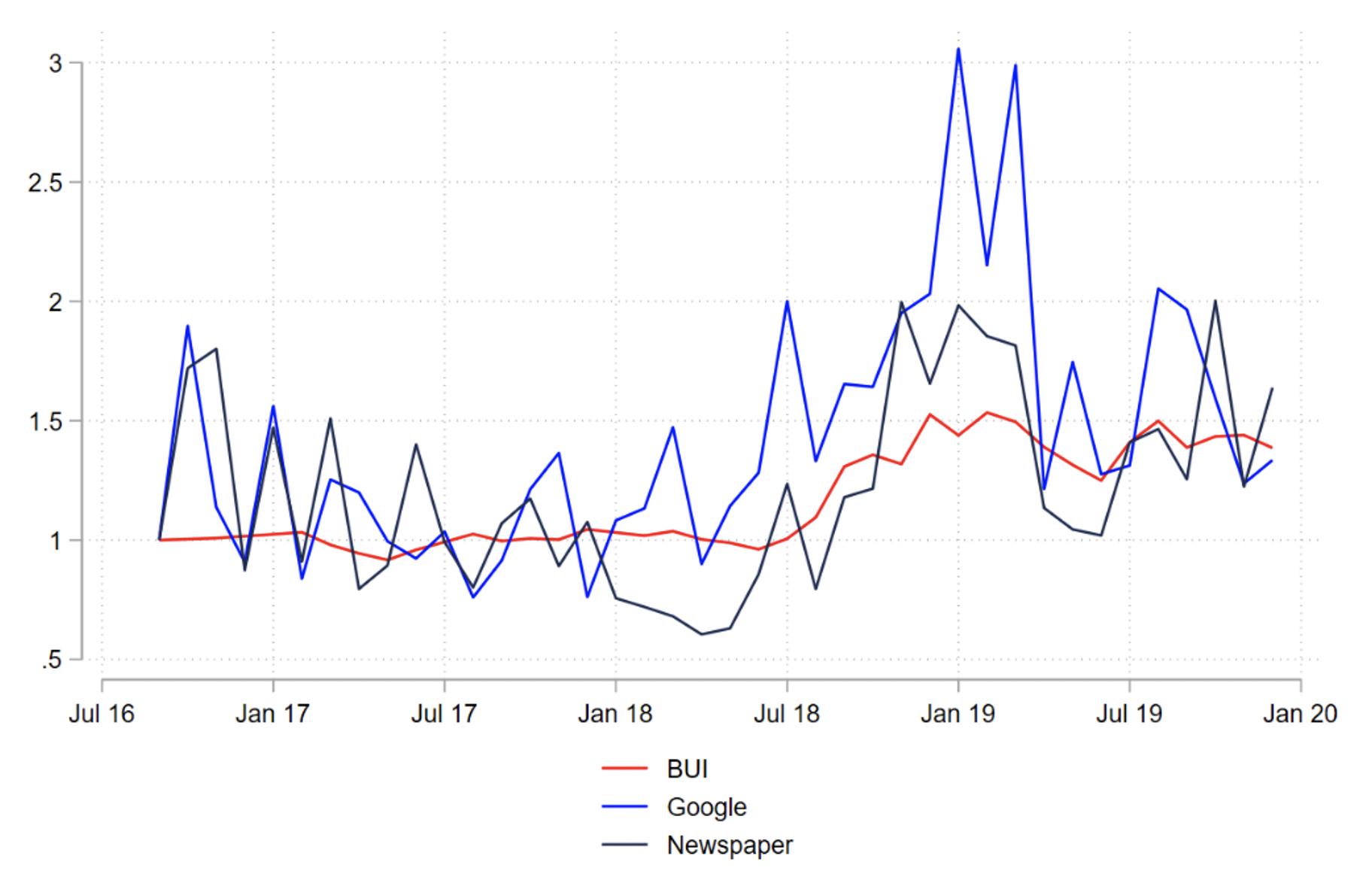A lot of research effort has gone into evaluating the impact of trade integration on labour market outcomes. Far less is known about the consequences of reversing existing trade agreements. The Brexit vote offers a unique opportunity to begin to study these consequences.
In our recent paper (Javorcik et al. 2020), we study how the outcome of the Brexit referendum, which introduced the threat of substantial barriers on trade in both goods and services with the EU, affected labour demand in the UK. We use a high-frequency dataset consisting of almost all job adverts posted online in the UK between January 2015 and December 2019. This allows us to shed new light on the labour demand response to these potential barriers throughout the Brexit negotiation period. Our study also adds new insights on this topic by focusing on the impact of future barriers to exports of services, in addition to considering barriers to trade in goods.
The UK electorate voted to leave the EU on 23 June 2016 with a lead of 3.8%. The unexpected nature of this vote was evidenced by the betting markets that had placed the likelihood of a ‘leave’ outcome at around 30% for most of the preceding year and the fact that the pound-dollar exchange rate fell by 8% in the 24 hours following the referendum, the biggest one-day loss since the 1970s.
The ‘threat’ of future export barriers
At the time of writing this column, no deal has been reached between the UK and the EU on their future trading relationship. If the UK leaves the EU and the EU’s Single Market without a deal, it will become a third party to European Economic Area (EEA) countries and trade in services and goods will be guided by terms set by the WTO agreements. This is the scenario considered in our study.
Our analysis takes the perspective of local labour markets, defined as ‘Travel to Work Areas’ (TTWAs). For each TTWA, we construct a measure of exposure to future barriers to exports of goods and services destined for EU countries. For services, the OECD Services Trade Restrictiveness Index (STRI) allows us to measure the difference in restrictions imposed by each of these countries on WTO members and other EEA members on exports of professional services.
UK industries’ exposure to such barriers depends on the pre-vote composition of exports by destination country. And, in turn, local labour markets’ exposure is based upon their pre-vote employment composition by industry. Figure 1 displays the UK local labour markets that were most exposed to the threat of professional services export barriers. These include Edinburgh, Halifax (headquarters of the Halifax Building Society), Trowbridge, and Swindon.
Figure 1 Professional services barrier exposure

Notes: This map displays the baseline employment-weighted professional services exposure for each TTWA. Darker colours represent more exposed areas. This chart presents the employment-weighted professional services exposure for the top 15 most exposed TTWAs. Sources: OECD, UN Comtrade
For goods trade, no trade deal with the EU will mean reverting from tariff-free trade to most-favoured nation (MFN) tariffs on UK exports to the EU. We exploit the product-level variation in EU MFN tariffs to construct measures of the tariff threat to sectors and local labour markets. Figure 2 displays the UK local labour markets that are most exposed to the threat of tariffs on goods exports. These include Hawick and Kelso, Whitehaven, and Fraserburgh.
Figure 2 Tariff exposure

Notes: This map displays the baseline employment-weighted tariff exposure for each TTWA. Darker colours represent more exposed areas. This graph displays the MFN tariff threat for the 15 most exposed TTWAs. Sources: World Integrated Trade Solution (WITS), UN Comtrade.
How did this threat of trade barriers affect local labour markets?
We follow a difference-in-differences approach, comparing job adverts in highly exposed localities to less exposed localities in the post-referendum period relative to the pre-referendum period. We control for two other channels through which the Brexit vote may have affected labour markets: the exchange rate depreciation and immigration policy uncertainty.
We find that:
- Regions that were ex ante more exposed to the threat of future trade barriers on professional services exports experienced a decline in online job postings after the referendum, relative to less exposed regions.
- This decline was economically meaningful: a one standard deviation increase in exposure to potential future barriers led to a 3.1% decrease in monthly job postings.
- The effect was mainly visible in higher skilled job adverts, with a particular impact on postings for executives, managers and professional occupations.
- The effect was concentrated primarily in financial services, information services, engineering and, to some extent, legal services.
- In contrast to services barriers, we find that the threat of future tariffs on goods does not seem to have had an effect on online job adverts.
Timing of the impact during the negotiation period
Three and a half years passed between the Brexit referendum and the UK officially leaving the EU on 31 January 2020. This period included three general elections, two changes of prime minister, multiple failed votes in parliament and three extensions to the date when the UK would officially leave the EU. Therefore, we also consider how the impact of trade barrier exposure varied over time.
Figure 3 shows the coefficient plot of our professional service exposure measure interacted with quarterly indicators. These results indicate that the impact on online job adverts was only felt from Q2 of 2018 onwards. This coincides with the publication of the UK Government’s White Paper on “The Future Relationship between the United Kingdom and the European Union” on the 12 July 2018. This paper clarified that the UK’s official position had moved away from the preferred option of ‘mutual recognition’ of the EEA and the UK’s financial services regulatory regimes, to focus on ‘equivalence’, which was seen as a far worse outcome for the financial services industry as the associated privileged access to the EEA could be revoked at a short notice.
Figure 3 Impact of professional service barrier exposure over time

Notes: This graph shows the coefficients from the regressions of the log of monthly job postings on the professional services barrier exposure measure at the TTWA level interacted with a dummy variable for each quarter from Q3 2015 to Q4 2019. Regressions also controlled for the EU immigrant share and the exchange rate measures interacted with the post vote dummy variables, TTWA fixed effects and month-year fixed effects. Coefficients are relative to the base period of Q1 2015 and Q2 2015. The dots represent the point estimates and the lines the 95 percent confidence intervals. The red line shows the quarter when the referendum occurred, Q2 2016.
To understand this impact over time in more detail, we construct two measures of time-varying Brexit-induced trade-policy uncertainty. The first uses the intensity with which the UK’s top ten newspapers were publishing articles mentioning both Brexit and uncertainty about the future trading relationship with the EU. The second uses the Google Search intensity in the UK for terms relating to both Brexit and trade policy. Figure 4 displays these normalised measures and also compares them with the Brexit Uncertainty Index (BUI) developed by Bloom et al. (2019). These measures all start to increase around mid-2018 and peak in early 2019.
Figure 4 Time-varying trade policy uncertainty indices

Notes: For illustrative purposes the measures are normalised to 1 on September 2016, non-normalised versions are used in regressions for simplicity. The newspaper index reflects the total number of articles in the UK’s top 10 newspapers including the relevant searches terms in each month. The google index shows the uncertainty measure constructed using google searches for key terms relating to Brexit and trade policy, it reflects search intensity for the relevant search terms in each month.
Using these measures, as well as the BUI, we show that the relative decline in online job adverts for regions more exposed to future professional services trade barriers was larger in months with heightened uncertainty over future trading policy arrangements with the EU. These results are not seen, however, when running a placebo test using the counterfactual of the postings that would have occurred had UK sectors followed the same trajectory as in the US, suggesting that the results do not just reflect sectoral trends.
What do these results imply for the whole country?
A back-of-the-envelope calculation suggests that approximately 1.5 million fewer job adverts were posted between June 2016 and December 2019 than would have occurred in the absence of exposure to these prospective services trade barriers. At an average monthly level, this is equivalent to 6.5% of postings when compared to average pre-vote levels.
Conclusions
Taken together, our results suggest that the threat of reversing trade integration with a country’s major trading partners can have a substantial effect on labour demand prior to the actual policy change taking place. For the UK, it was the threat of barriers on trade in services that mattered the most, rather than the threat of barriers on goods trade, despite the often greater focus on tariffs and goods supply chains during the discourse around the economic impacts of Brexit.
To read the full piece from VOX EU, please click here
